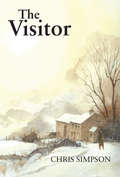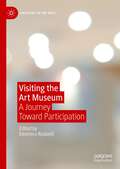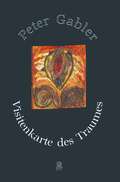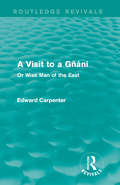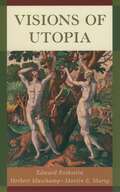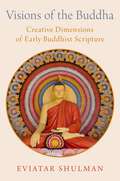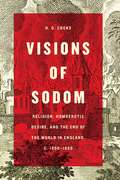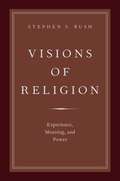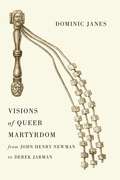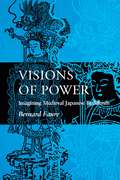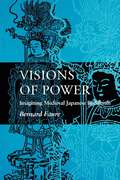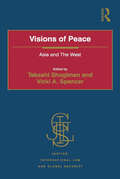- Table View
- List View
The Visitor: Andre Palmeiro and the Jesuits in Asia
by Liam Matthew BrockeyIn an age when few ventured beyond their birthplace, André Palmeiro left Portugal to inspect Jesuit missions from Mozambique to Japan. A global history in the guise of biography, The Visitor tells the story of a theologian whose travels bore witness to the fruitful contact—and violent collision—of East and West in the early modern era.
The Visitor: A Christmas Story from the Yorkshire Dales
by Chris SimpsonEach line of this beautifully crafted Christmas story evokes the rugged countryside that the author loves, the heartlands of the Yorkshire Dales. A moving and charming story to warm our hearts at Christmas time. *** Jos Robertshaw and his wife, Emily, are Yorkshire hill farmers, used to being self-sufficient in a hard and sometimes bleak landscape. On a cold and snowy night when they open the door of their self-contained world to a mysterious visitor nothing will ever be quite the same again.
Visiting the Art Museum: A Journey Toward Participation (Sociology of the Arts)
by Eleonora RedaelliVisiting the Art Museum: A Journey Toward Participation is a book about the visitor experience. It is written as a companion for visitors to and inside the art museum. The volume engages readers in transforming a common experience, the museum visit, into a sophisticated epistemological inquiry. The study of the visitor experience through an epistemological approach consists of the untangling of the academic disciplines that study and inform each step of this experience: urban studies, architecture, design, art history, art education, and nonprofit management. This journey follows a transformative bottom-up trajectory from experiential to epistemological, and, finally, reveals itself as empowering. The book unfolds as an edited volume, with chapters by different authors who are enthusiastic scholars in each discipline and addresses undergraduate students as citizens, master’s students as professionals, and scholars as teachers and researchers. Each reader will discover a kaleidoscopic world made of ideas, values, and possibilities for participation.
A Visitation of God: Northern Civilians Interpret the Civil War
by Sean A. ScottThis book examines the Civil War from the perspective of the northern laity, those religious civilians whose personal faith influenced their views on politics and slavery, helped them cope with physical separation and death engendered by the war, and ultimately enabled them to discern the hand of God in the struggle to preserve the national Union. From Lincoln's election to his assassination, the book weaves together political, military, social, and intellectual history into a religious narrative of the Civil War on the northern home front. Packed with compelling human interest stories, this account draws on letters, diaries, newspapers and church records along with published sources to conclusively demonstrate that many devout civilians regarded the Civil War as a contest imbued with religious meaning. In the process of giving their loyal support to the government as individual citizens, religious Northerners politicized the church as a collective institution and used it to uphold the Union so the purified nation could promote Christianity around the world. Christian patriotism helped win the war, but the politicization of religion did not lead to the redemption of the state.
A Visitation of God: Northern Civilians Interpret the Civil War
by Sean A. ScottThis book examines the Civil War from the perspective of the northern laity, those religious civilians whose personal faith influenced their views on politics and slavery, helped them cope with physical separation and death engendered by the war, and ultimately enabled them to discern the hand of God in the struggle to preserve the national Union. From Lincoln's election to his assassination, the book weaves together political, military, social, and intellectual history into a religious narrative of the Civil War on the northern home front. Packed with compelling human interest stories, this account draws on letters, diaries, newspapers and church records along with published sources to conclusively demonstrate that many devout civilians regarded the Civil War as a contest imbued with religious meaning. In the process of giving their loyal support to the government as individual citizens, religious Northerners politicized the church as a collective institution and used it to uphold the Union so the purified nation could promote Christianity around the world. Christian patriotism helped win the war, but the politicization of religion did not lead to the redemption of the state.
A Visit to a Gñáni: Or Wise Man of the East (Routledge Revivals: The Collected Works of Edward Carpenter)
by Edward CarpenterOriginally published in 1911, this edition published in 1920, this text comprises of an excerpt from Carpenter’s Adam’s Peak to Elephanta, originally published in 1892, which details his travels in India and Ceylon. This excerpt in particular details his visit to a Gñáni, or religious wise man, and what he learned of their ancient wisdom-religion, which would be more recognisable as Hinduism to a modern reader. This title will be of interest to students of sociology, anthropology and religious studies.
A Visit to a Gñáni: Or Wise Man of the East (Routledge Revivals: The Collected Works of Edward Carpenter)
by Edward CarpenterOriginally published in 1911, this edition published in 1920, this text comprises of an excerpt from Carpenter’s Adam’s Peak to Elephanta, originally published in 1892, which details his travels in India and Ceylon. This excerpt in particular details his visit to a Gñáni, or religious wise man, and what he learned of their ancient wisdom-religion, which would be more recognisable as Hinduism to a modern reader. This title will be of interest to students of sociology, anthropology and religious studies.
The Visions, Revelations and Teachings of Angela of Foligno: A Member of the Third Order of St Francis
Angela of Foligno was born in about 1248, twenty-two years after the death of Francis of Assisi, the saint on whom she was to model her life. With sudden deaths in her family, she felt called to follow a more religious and devout life, forsaking everything. In the years that followed she lived a life of total commitment to God. Her teachings and visions, and her deep spiritual wisdom, became internationally recognized as coming from a blessed person. This book provides the reader with a selection of Angela's visions and teachings drawn from The Divine Consolations of Angela of Foligno.
Visions of Utopia (New York Public Library Lectures in Humanities)
by Martin Marty Herbert Muschamp Edward RothsteinFrom the sex-free paradise of the Shakers to the worker's paradise of Marx, utopian ideas seem to have two things in common--they all are wonderfully plausible at the start and they all end up as disasters. In Visions of Utopia, three leading cultural critics--Edward Rothstein, Martin Marty, and Herbert Muschamp--look at the history of utopian thinking, exploring why they fail and why they are still worth pursuing. Edward Rothstein, New York Times cultural critic, contends that every utopia is really a dystopia--a disaster in the making--one that overlooks the nature of humanity and the impossibilities of paradise. He traces the ideal in politics and technology and suggests that only in art--and especially in music--does the desire for utopia find satisfaction. Martin Marty examines several models of utopia--from Thomas More's to a 1960s experimental city that he helped to plan--to show that, even though utopias can never be realized, we should not be too quick to condemn them. They can express dimensions of the human spirit that might otherwise be stifled and can plant ideas that may germinate in more realistic and practical soil. And Herbert Muschamp, the New York Times architectural critic, looks at Utopianism as exemplified in two different ways: the Buddhist tradition and the work of visionary Viennese architect Adolph Loos. Utopian thinking embodies humanity's noblest impulses, yet it can lead to horrors such as Nazi Germany and the Soviet Regime. In Visions of Utopia, these leading thinkers offer an intriguing look at the paradoxes of paradise.
Visions of Utopia (New York Public Library Lectures in Humanities)
by Edward Rothstein Herbert Muschamp Martin MartyFrom the sex-free paradise of the Shakers to the worker's paradise of Marx, utopian ideas seem to have two things in common--they all are wonderfully plausible at the start and they all end up as disasters. In Visions of Utopia, three leading cultural critics--Edward Rothstein, Martin Marty, and Herbert Muschamp--look at the history of utopian thinking, exploring why they fail and why they are still worth pursuing. Edward Rothstein, New York Times cultural critic, contends that every utopia is really a dystopia--a disaster in the making--one that overlooks the nature of humanity and the impossibilities of paradise. He traces the ideal in politics and technology and suggests that only in art--and especially in music--does the desire for utopia find satisfaction. Martin Marty examines several models of utopia--from Thomas More's to a 1960s experimental city that he helped to plan--to show that, even though utopias can never be realized, we should not be too quick to condemn them. They can express dimensions of the human spirit that might otherwise be stifled and can plant ideas that may germinate in more realistic and practical soil. And Herbert Muschamp, the New York Times architectural critic, looks at Utopianism as exemplified in two different ways: the Buddhist tradition and the work of visionary Viennese architect Adolph Loos. Utopian thinking embodies humanity's noblest impulses, yet it can lead to horrors such as Nazi Germany and the Soviet Regime. In Visions of Utopia, these leading thinkers offer an intriguing look at the paradoxes of paradise.
Visions of the Buddha: Creative Dimensions of Early Buddhist Scripture
by Eviatar ShulmanVisions of the Buddha offers a ground-breaking approach to the nature of the early discourses of the Buddha, the most foundational scriptures of Buddhist religion. Although the early discourses are commonly considered to be attempts to preserve the Buddha's teachings, Shulman demonstrates that these texts are full of creativity, and that their main aim is to beautify the image of the wonderous Buddha. While the texts surely care for the early teachings and for the Buddha's philosophy or his guidelines for meditation, and while at times they may relate real historical events, they are no less interested in telling good stories, in re-working folkloric materials, and in the visionary contemplation of the Buddha in order to sense his unique presence. The texts can thus be, at times, a type of meditation. Eviatar Shulman frames the early discourses as literary masterpieces that helped Buddhism achieve the wonderful success it has obtained. Much of the discourses' masterful storytelling was achieved through a technique of composition defined here as the play of formulas. In the oral literature of early Buddhism, texts were composed of formulas, which are repeated within and between texts. Shulman argues that the formulas are the real texts of Buddhism, and are primary to full discourses. Shaping texts through the play of formulas balances conservative and innovative tendencies within the tradition, making room for creativity within accepted forms and patterns. The texts we find today are thus versions--remnants--chosen by history of a much more vibrant and dynamic creative process.
Visions of the Buddha: Creative Dimensions of Early Buddhist Scripture
by Eviatar ShulmanVisions of the Buddha offers a ground-breaking approach to the nature of the early discourses of the Buddha, the most foundational scriptures of Buddhist religion. Although the early discourses are commonly considered to be attempts to preserve the Buddha's teachings, Shulman demonstrates that these texts are full of creativity, and that their main aim is to beautify the image of the wonderous Buddha. While the texts surely care for the early teachings and for the Buddha's philosophy or his guidelines for meditation, and while at times they may relate real historical events, they are no less interested in telling good stories, in re-working folkloric materials, and in the visionary contemplation of the Buddha in order to sense his unique presence. The texts can thus be, at times, a type of meditation. Eviatar Shulman frames the early discourses as literary masterpieces that helped Buddhism achieve the wonderful success it has obtained. Much of the discourses' masterful storytelling was achieved through a technique of composition defined here as the play of formulas. In the oral literature of early Buddhism, texts were composed of formulas, which are repeated within and between texts. Shulman argues that the formulas are the real texts of Buddhism, and are primary to full discourses. Shaping texts through the play of formulas balances conservative and innovative tendencies within the tradition, making room for creativity within accepted forms and patterns. The texts we find today are thus versions--remnants--chosen by history of a much more vibrant and dynamic creative process.
Visions of Sodom: Religion, Homoerotic Desire, and the End of the World in England, c. 1550-1850
by H. G. CocksThe book of Genesis records the fiery fate of Sodom and Gomorrah—a storm of fire and brimstone was sent from heaven and, for the wickedness of the people, God destroyed the cities “and all the plains, and all the inhabitants of the cities, and that which grew upon the ground.” According to many Protestant theologians and commentators, one of the Sodomites’ many crimes was homoerotic excess. In Visions of Sodom, H. G. Cocks examines the many different ways in which the story of Sodom’s destruction provided a template for understanding homoerotic desire and behaviour in Britain between the Reformation and the nineteenth century. Sodom was not only a marker of sexual sins, but also the epitome of false—usually Catholic—religion, an exemplar of the iniquitous city, a foreshadowing of the world’s fiery end, an epitome of divine and earthly punishment, and an actual place that could be searched for and discovered. Visions of Sodom investigates each of these ways of reading Sodom’s annihilation in the three hundred years after the Reformation. The centrality of scripture to Protestant faith meant that Sodom’s demise provided a powerful origin myth of homoerotic desire and sexual excess, one that persisted across centuries, and retains an apocalyptic echo in the religious fundamentalism of our own time.
Visions of Sodom: Religion, Homoerotic Desire, and the End of the World in England, c. 1550-1850
by H. G. CocksThe book of Genesis records the fiery fate of Sodom and Gomorrah—a storm of fire and brimstone was sent from heaven and, for the wickedness of the people, God destroyed the cities “and all the plains, and all the inhabitants of the cities, and that which grew upon the ground.” According to many Protestant theologians and commentators, one of the Sodomites’ many crimes was homoerotic excess. In Visions of Sodom, H. G. Cocks examines the many different ways in which the story of Sodom’s destruction provided a template for understanding homoerotic desire and behaviour in Britain between the Reformation and the nineteenth century. Sodom was not only a marker of sexual sins, but also the epitome of false—usually Catholic—religion, an exemplar of the iniquitous city, a foreshadowing of the world’s fiery end, an epitome of divine and earthly punishment, and an actual place that could be searched for and discovered. Visions of Sodom investigates each of these ways of reading Sodom’s annihilation in the three hundred years after the Reformation. The centrality of scripture to Protestant faith meant that Sodom’s demise provided a powerful origin myth of homoerotic desire and sexual excess, one that persisted across centuries, and retains an apocalyptic echo in the religious fundamentalism of our own time.
Visions of Sodom: Religion, Homoerotic Desire, and the End of the World in England, c. 1550-1850
by H. G. CocksThe book of Genesis records the fiery fate of Sodom and Gomorrah—a storm of fire and brimstone was sent from heaven and, for the wickedness of the people, God destroyed the cities “and all the plains, and all the inhabitants of the cities, and that which grew upon the ground.” According to many Protestant theologians and commentators, one of the Sodomites’ many crimes was homoerotic excess. In Visions of Sodom, H. G. Cocks examines the many different ways in which the story of Sodom’s destruction provided a template for understanding homoerotic desire and behaviour in Britain between the Reformation and the nineteenth century. Sodom was not only a marker of sexual sins, but also the epitome of false—usually Catholic—religion, an exemplar of the iniquitous city, a foreshadowing of the world’s fiery end, an epitome of divine and earthly punishment, and an actual place that could be searched for and discovered. Visions of Sodom investigates each of these ways of reading Sodom’s annihilation in the three hundred years after the Reformation. The centrality of scripture to Protestant faith meant that Sodom’s demise provided a powerful origin myth of homoerotic desire and sexual excess, one that persisted across centuries, and retains an apocalyptic echo in the religious fundamentalism of our own time.
Visions of Sodom: Religion, Homoerotic Desire, and the End of the World in England, c. 1550-1850
by H. G. CocksThe book of Genesis records the fiery fate of Sodom and Gomorrah—a storm of fire and brimstone was sent from heaven and, for the wickedness of the people, God destroyed the cities “and all the plains, and all the inhabitants of the cities, and that which grew upon the ground.” According to many Protestant theologians and commentators, one of the Sodomites’ many crimes was homoerotic excess. In Visions of Sodom, H. G. Cocks examines the many different ways in which the story of Sodom’s destruction provided a template for understanding homoerotic desire and behaviour in Britain between the Reformation and the nineteenth century. Sodom was not only a marker of sexual sins, but also the epitome of false—usually Catholic—religion, an exemplar of the iniquitous city, a foreshadowing of the world’s fiery end, an epitome of divine and earthly punishment, and an actual place that could be searched for and discovered. Visions of Sodom investigates each of these ways of reading Sodom’s annihilation in the three hundred years after the Reformation. The centrality of scripture to Protestant faith meant that Sodom’s demise provided a powerful origin myth of homoerotic desire and sexual excess, one that persisted across centuries, and retains an apocalyptic echo in the religious fundamentalism of our own time.
Visions of Religion: Experience, Meaning, and Power (AAR Reflection and Theory in the Study of Religion)
by Stephen S. BushWinner of the Gustave O. Arlt Award in the Humanities Three understandings of the nature of religion--religion as experience, symbolic meaning, and power--have dominated scholarly discussions, in succession, for the past hundred years. Proponents of each of these three approaches have tended to downplay, ignore, or actively criticize the others. But why should the three approaches be at odds? Religion as it is practiced involves experiences, meanings, and power, so students of religion should attend to all three. Furthermore, theorists of religion should have an account that carefully conceptualizes all three aspects, without regarding any of them as more basic than the others. Visions of Religion provides just such an account. Stephen S. Bush examines influential proponents of the three visions, arguing that each approach offers substantial and lasting contributions to the study of religion, although each requires revision. Bush rehabilitates the concepts of experience and meaning, two categories that are much maligned these days. In doing so, he shows the extent to which these categories are implicated in matters of social power. As for power, the book argues that the analysis of power requires attention to meaning and experience. Visions of Religion accomplishes all this by articulating a social practical theory of religion that can account for all three aspects, even as it incorporates them into a single theoretical framework.
Visions of Queer Martyrdom from John Henry Newman to Derek Jarman
by Dominic JanesWith all the heated debates around religion and homosexuality today, it might be hard to see the two as anything but antagonistic. But in this book, Dominic Janes reveals the opposite: Catholic forms of Christianity, he explains, played a key role in the evolution of the culture and visual expression of homosexuality and male same-sex desire in the nineteenth and twentieth centuries. He explores this relationship through the idea of queer martyrdom—closeted queer servitude to Christ—a concept that allowed a certain degree of latitude for the development of same-sex desire. Janes finds the beginnings of queer martyrdom in the nineteenth-century Church of England and the controversies over Cardinal John Henry Newman’s sexuality. He then considers how liturgical expression of queer desire in the Victorian Eucharist provided inspiration for artists looking to communicate their own feelings of sexual deviance. After looking at Victorian monasteries as queer families, he analyzes how the Biblical story of David and Jonathan could be used to create forms of same-sex partnerships. Finally, he delves into how artists and writers employed ecclesiastical material culture to further queer self-expression, concluding with studies of Oscar Wilde and Derek Jarman that illustrate both the limitations and ongoing significance of Christianity as an inspiration for expressions of homoerotic desire. Providing historical context to help us reevaluate the current furor over homosexuality in the Church, this fascinating book brings to light the myriad ways that modern churches and openly gay men and women can learn from the wealth of each other’s cultural and spiritual experience.
Visions of Queer Martyrdom from John Henry Newman to Derek Jarman
by Dominic JanesWith all the heated debates around religion and homosexuality today, it might be hard to see the two as anything but antagonistic. But in this book, Dominic Janes reveals the opposite: Catholic forms of Christianity, he explains, played a key role in the evolution of the culture and visual expression of homosexuality and male same-sex desire in the nineteenth and twentieth centuries. He explores this relationship through the idea of queer martyrdom—closeted queer servitude to Christ—a concept that allowed a certain degree of latitude for the development of same-sex desire. Janes finds the beginnings of queer martyrdom in the nineteenth-century Church of England and the controversies over Cardinal John Henry Newman’s sexuality. He then considers how liturgical expression of queer desire in the Victorian Eucharist provided inspiration for artists looking to communicate their own feelings of sexual deviance. After looking at Victorian monasteries as queer families, he analyzes how the Biblical story of David and Jonathan could be used to create forms of same-sex partnerships. Finally, he delves into how artists and writers employed ecclesiastical material culture to further queer self-expression, concluding with studies of Oscar Wilde and Derek Jarman that illustrate both the limitations and ongoing significance of Christianity as an inspiration for expressions of homoerotic desire. Providing historical context to help us reevaluate the current furor over homosexuality in the Church, this fascinating book brings to light the myriad ways that modern churches and openly gay men and women can learn from the wealth of each other’s cultural and spiritual experience.
Visions of Queer Martyrdom from John Henry Newman to Derek Jarman
by Dominic JanesWith all the heated debates around religion and homosexuality today, it might be hard to see the two as anything but antagonistic. But in this book, Dominic Janes reveals the opposite: Catholic forms of Christianity, he explains, played a key role in the evolution of the culture and visual expression of homosexuality and male same-sex desire in the nineteenth and twentieth centuries. He explores this relationship through the idea of queer martyrdom—closeted queer servitude to Christ—a concept that allowed a certain degree of latitude for the development of same-sex desire. Janes finds the beginnings of queer martyrdom in the nineteenth-century Church of England and the controversies over Cardinal John Henry Newman’s sexuality. He then considers how liturgical expression of queer desire in the Victorian Eucharist provided inspiration for artists looking to communicate their own feelings of sexual deviance. After looking at Victorian monasteries as queer families, he analyzes how the Biblical story of David and Jonathan could be used to create forms of same-sex partnerships. Finally, he delves into how artists and writers employed ecclesiastical material culture to further queer self-expression, concluding with studies of Oscar Wilde and Derek Jarman that illustrate both the limitations and ongoing significance of Christianity as an inspiration for expressions of homoerotic desire. Providing historical context to help us reevaluate the current furor over homosexuality in the Church, this fascinating book brings to light the myriad ways that modern churches and openly gay men and women can learn from the wealth of each other’s cultural and spiritual experience.
Visions of Queer Martyrdom from John Henry Newman to Derek Jarman
by Dominic JanesWith all the heated debates around religion and homosexuality today, it might be hard to see the two as anything but antagonistic. But in this book, Dominic Janes reveals the opposite: Catholic forms of Christianity, he explains, played a key role in the evolution of the culture and visual expression of homosexuality and male same-sex desire in the nineteenth and twentieth centuries. He explores this relationship through the idea of queer martyrdom—closeted queer servitude to Christ—a concept that allowed a certain degree of latitude for the development of same-sex desire. Janes finds the beginnings of queer martyrdom in the nineteenth-century Church of England and the controversies over Cardinal John Henry Newman’s sexuality. He then considers how liturgical expression of queer desire in the Victorian Eucharist provided inspiration for artists looking to communicate their own feelings of sexual deviance. After looking at Victorian monasteries as queer families, he analyzes how the Biblical story of David and Jonathan could be used to create forms of same-sex partnerships. Finally, he delves into how artists and writers employed ecclesiastical material culture to further queer self-expression, concluding with studies of Oscar Wilde and Derek Jarman that illustrate both the limitations and ongoing significance of Christianity as an inspiration for expressions of homoerotic desire. Providing historical context to help us reevaluate the current furor over homosexuality in the Church, this fascinating book brings to light the myriad ways that modern churches and openly gay men and women can learn from the wealth of each other’s cultural and spiritual experience.
Visions of Power: Imagining Medieval Japanese Buddhism
by Bernard FaureBernard Faure's previous works are well known as guides to some of the more elusive aspects of the Chinese tradition of Chan Buddhism and its outgrowth, Japanese Zen. Continuing his efforts to look at Chan/Zen with a full array of postmodernist critical techniques, Faure now probes the imaginaire, or mental universe, of the Buddhist Soto Zen master Keizan Jokin (1268-1325). Although Faure's new book may be read at one level as an intellectual biography, Keizan is portrayed here less as an original thinker than as a representative of his culture and an example of the paradoxes of the Soto school. The Chan/Zen doctrine that he avowed was allegedly reasonable and demythologizing, but he lived in a psychological world that was just as imbued with the marvelous as was that of his contemporary Dante Alighieri. Drawing on his own dreams to demonstrate that he possessed the magical authority that he felt to reside also in icons and relics, Keizan strove to use these "visions of power" to buttress his influence as a patriarch. To reveal the historical, institutional, ritual, and visionary elements in Keizan's life and thought and to compare these to Soto doctrine, Faure draws on largely neglected texts, particularly the Record of Tokoku (a chronicle that begins with Keizan's account of the origins of the first of the monasteries that he established) and the kirigami, or secret initiation documents.
Visions of Power: Imagining Medieval Japanese Buddhism
by Bernard Faure Phyllis BrooksBernard Faure's previous works are well known as guides to some of the more elusive aspects of the Chinese tradition of Chan Buddhism and its outgrowth, Japanese Zen. Continuing his efforts to look at Chan/Zen with a full array of postmodernist critical techniques, Faure now probes the imaginaire, or mental universe, of the Buddhist Soto Zen master Keizan Jokin (1268-1325). Although Faure's new book may be read at one level as an intellectual biography, Keizan is portrayed here less as an original thinker than as a representative of his culture and an example of the paradoxes of the Soto school. The Chan/Zen doctrine that he avowed was allegedly reasonable and demythologizing, but he lived in a psychological world that was just as imbued with the marvelous as was that of his contemporary Dante Alighieri. Drawing on his own dreams to demonstrate that he possessed the magical authority that he felt to reside also in icons and relics, Keizan strove to use these "visions of power" to buttress his influence as a patriarch. To reveal the historical, institutional, ritual, and visionary elements in Keizan's life and thought and to compare these to Soto doctrine, Faure draws on largely neglected texts, particularly the Record of Tokoku (a chronicle that begins with Keizan's account of the origins of the first of the monasteries that he established) and the kirigami, or secret initiation documents.
Visions of Peace: Asia and The West (Justice, International Law and Global Security)
by Vicki A. Spencer Takashi ShogimenVisions of Peace: Asia and the West explores the diversity of past conceptualizations as well as the remarkable continuity in the hope for peace across global intellectual traditions. Current literature, prompted by September 11, predominantly focuses on the laws and ethics of just wars or modern ideals of peace. Asian and Western ideals of peace before the modern era have largely escaped scholarly attention. This book examines Western and Asian visions of peace that existed prior to c.1800 by bringing together experts from a variety of intellectual traditions. The historical survey ranges from ancient Greek thought, early Christianity and medieval scholasticism to Hinduism, classical Confucianism and Tokuguwa Japanese learning, before illuminating unfamiliar aspects of peace visions in the European Enlightenment. Each chapter offers a particular case study and attempts to rehabilitate a 'forgotten' conception of peace and reclaim its contemporary relevance. Collectively they provide the conceptual resources to inspire more creative thinking towards a new vision of peace in the present. Students and specialists in international relations, peace studies, history, political theory, philosophy, and religious studies will find this book a valuable resource on diverse conceptions of peace.

